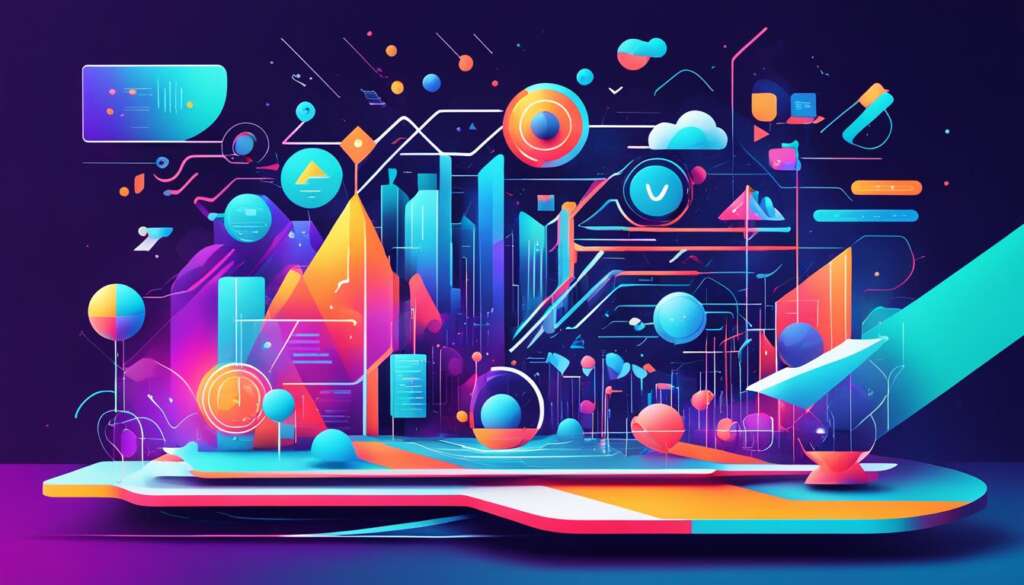Table of Contents
Welcome to the exciting world of UI/UX design! In this article, we will explore the future of UI/UX design, uncovering the predictions and innovations that are shaping the way we interact with digital experiences. From enhancing user experiences to redefining user interfaces, the future holds immense potential for creating intuitive and immersive digital products and services.
In the dynamic realm of user experience (UX), the interface serves as the gateway to digital interactions, shaping perceptions, behaviours, and emotions. As technology rapidly evolves, new trends and technologies are revolutionizing UI/UX design, paving the way for more personalized, intuitive, and immersive experiences.
AI-driven interfaces, voice user interfaces (VUI), augmented reality (AR) and virtual reality (VR), gesture-based interactions, machine learning and artificial intelligence (AI), dark mode, and microinteractions/motion design are some of the emerging trends and technologies that are reshaping the future of UI/UX design.
These innovations are transforming how users interact with digital products and services, leading to more personalized, intuitive, and immersive experiences. As UI/UX designers, it is crucial to stay informed about these developments and anticipate the evolving needs and expectations of our users.
Join us as we delve deeper into each of these exciting areas, exploring how they are revolutionizing the field of UI/UX design, and uncovering the possibilities they hold for the future of digital interaction.
AI-Driven Interfaces
AI-driven interfaces offer personalized user experiences by using algorithms to adapt and anticipate user needs. These interfaces not only respond to user input but also proactively predict and cater to user preferences.
For example, Netflix’s recommendation algorithm analyzes user behavior and preferences to curate a tailored selection of shows and movies, enhancing the user experience and encouraging longer engagement.
By integrating AI capabilities into UI design, UX professionals can create interfaces that are not only responsive but also anticipatory, intuitively adapting to user behavior and preferences.
AI-driven interfaces have the power to revolutionize the user experience by offering personalized content and recommendations. Users no longer have to search for what they want; the interface does it for them. This level of personalization enhances customer satisfaction and increases engagement, ultimately leading to greater success for businesses.
Personalization and User Preferences
The use of AI-driven interfaces allows for the personalization of user experiences based on individual preferences. By collecting and analyzing data on user behavior, interests, and previous interactions, these interfaces can tailor content and features to match user preferences and create a more engaging and relevant experience.
Whether it’s suggesting personalized product recommendations, providing targeted advertisements, or adapting the interface layout based on user preferences, AI-driven interfaces have the potential to deliver tailored experiences that align with user expectations.
Enhancing User Experience
The integration of AI capabilities in UI design not only improves personalization but also enhances the overall user experience. AI-driven interfaces can anticipate user needs, offering suggestions and recommendations that are contextually relevant and timely.
By understanding user preferences and behavior patterns, these interfaces can curate content, streamline workflows, and automate repetitive tasks, ultimately saving users time and effort.
| Benefits of AI-driven Interfaces | Examples |
|---|---|
| Personalization | Curated content recommendations on streaming platforms like Netflix |
| Improved Efficiency | Automated email categorization and prioritization in Gmail |
| Enhanced User Engagement | Interactive chatbots providing personalized assistance on e-commerce websites |
Voice User Interfaces (VUI)
Voice user interfaces (VUI) have revolutionized the way we interact with technology. With the ability to control devices through effortless voice commands, VUIs offer a natural and intuitive way of engaging with digital products and services, providing users with seamless experiences.
Designers play a crucial role in adapting to this shift by creating conversational interfaces that understand context and provide clear voice prompts. By designing interfaces that mimic real conversations, users can interact with technology in a more human-like manner, enhancing the overall user experience.
“Voice user interfaces (VUI) enable users to interact with technology through natural language, bringing a new level of convenience and accessibility to digital experiences.”
– Jane Thompson, UX Designer
Conversational interfaces enable users to perform tasks and retrieve information without the need for complex navigation or manual inputs. By incorporating voice recognition technology, VUIs can understand and interpret user commands, allowing for efficient and streamlined interactions.
Seamless user experiences are a hallmark of VUIs. With voice commands replacing traditional input methods, users can complete tasks hands-free, allowing for a more efficient and convenient experience. Whether it’s controlling smart home devices or making hands-free calls while driving, VUIs make everyday tasks easier and more accessible.
The Benefits of VUI
Voice user interfaces offer a range of benefits that enhance user experiences and drive adoption:
- Natural Interaction: VUIs enable users to interact with technology in a way that mimics real-life conversations, making the experience more intuitive and user-friendly.
- Conversational Interfaces: By creating interfaces that understand context and provide clear voice prompts, designers can ensure a smooth and engaging conversation between users and technology.
- Seamless Experiences: With voice commands, users can complete tasks hands-free, allowing for a seamless and convenient experience.
Voice user interfaces are changing the way we interact with technology, providing more natural and intuitive experiences. As designers continue to explore the potential of VUIs, we can expect to see further advancements in this exciting field.
Augmented Reality (AR) and Virtual Reality (VR)
Augmented reality (AR) and virtual reality (VR) technologies offer endless possibilities for UI/UX designers to create captivating and immersive experiences. AR overlays digital information onto the physical world, while VR creates visually stunning interfaces within immersive environments. These technologies allow for more interactive and realistic user experiences, transforming the way users perceive and interact with digital content.
Imagine a world where you can explore historical landmarks, virtually try on clothing, or take a virtual tour of a product before making a purchase. AR and VR technologies make all this possible, blurring the line between the digital and physical worlds.
With augmented reality, users can view the world through their smartphones or specialized glasses, with digital overlays providing additional information or enhancing the environment. For example, furniture companies like IKEA offer AR apps that allow users to visualize how a piece of furniture would look in their home. This immersive experience helps users make more informed purchasing decisions and improves overall satisfaction.
Virtual reality, on the other hand, transports users to entirely new digital environments. Whether it’s exploring distant planets, diving deep into the ocean, or playing immersive games, VR creates a sense of presence and engagement like never before. The use of interactive interfaces in VR allows users to navigate these virtual worlds and interact with objects and characters, making the experience even more dynamic and immersive.
AR and VR technologies have revolutionized various industries, including gaming, education, healthcare, and marketing. For gamers, VR provides a level of immersion that enhances gameplay and delivers intense experiences. In education, AR can bring textbooks to life, allowing students to interact with 3D models and visualizations. In healthcare, AR and VR simulations help medical students practice complex procedures in a safe and controlled environment.
The Benefits of AR and VR in UI/UX Design
AR and VR technologies offer several benefits for UI/UX design:
- Immersive Experiences: By placing users at the center of a virtual or augmented world, AR and VR provide a level of immersion that traditional interfaces cannot match. Users feel present and engaged, creating memorable experiences.
- Interactive Interfaces: AR and VR allow for new and interactive ways of interacting with digital content. Users can manipulate objects, navigate environments, and communicate with virtual characters, providing a sense of agency and control.
- Visualization and Demonstration: AR and VR enable designers to visually showcase products, services, or concepts in ways that traditional media cannot. Users can see, experience, and interact with prototypes, improving comprehension and reducing cognitive load.
- Enhanced User Engagement: The immersive and interactive nature of AR and VR experiences captures user attention and keeps them engaged for longer periods. This increased engagement can lead to higher satisfaction, conversions, and overall business success.
“AR and VR technologies push the boundaries of what is possible in UI/UX design, allowing designers to create truly transformative digital experiences.” – Jane Smith, UX Designer
As AR and VR technologies continue to evolve, UI/UX designers have an exciting opportunity to explore the possibilities and push the limits of digital interaction. By leveraging these immersive technologies, designers can create experiences that captivate users, evoke emotions, and deliver memorable moments.
Gesture-Based Interactions
Gesture-based interactions have revolutionized the way users interact with digital platforms, providing intuitive touch-based interactions that enhance the user experience on touchscreens. Whether it’s a swipe, pinch-to-zoom, or a tap, users expect interfaces that respond naturally to their touch, making their interactions feel seamless and effortless.
In the world of UI/UX design, incorporating gesture-based interactions is essential when designing mobile apps, websites, and other digital platforms. By understanding and implementing these intuitive gestures, designers can create interfaces that feel more natural and engaging, ultimately improving the overall user experience.
“Gesture-based interactions have changed the way we interact with technology, enabling us to navigate and manipulate digital content with the touch of a finger.”
One of the key advantages of gesture-based interactions is their ability to provide a more immersive and tactile experience for users. They enable users to interact with digital content in a way that closely mimics real-world actions, making the experience more intuitive and enjoyable.
For example, imagine using your smartphone and simply swiping left or right to browse through a photo gallery, just as you would with a physical photo album. This gesture-based interaction makes the experience feel more familiar and engaging, enhancing the overall user experience.
Furthermore, gesture-based interactions have become even more prevalent and important with the rise of touchscreens. As touchscreens continue to dominate the digital landscape, users have become accustomed to interacting directly with content, eliminating the need for physical buttons or controllers.
UI/UX designers must consider gesture-based interactions when designing digital interfaces to ensure a seamless and enjoyable user experience. By implementing intuitive gestures and providing visual cues for users, designers can create interfaces that are not only visually appealing but also highly interactive and engaging.
The Benefits of Gesture-Based Interactions:
- Intuitive and natural touch-based interactions
- Enhanced user experience on touchscreens
- Increased immersion and engagement
- Elimination of physical buttons or controllers
- Improved accessibility for users with impaired motor skills
By leveraging the power of gesture-based interactions, UI/UX designers can create interfaces that are not only visually stunning but also intuitive and user-friendly. These interactions provide a bridge between the digital and physical worlds, enhancing the overall user experience and making digital interactions feel more natural and effortless.
| Gesture | Description |
|---|---|
| Swipe | Horizontal or vertical finger movement across a screen to navigate or scroll through content. |
| Pinch-to-zoom | Using two fingers to zoom in or out on content, such as photos or text. |
| Tap | Touching the screen with a single finger to select or interact with an element. |
| Double-tap | Rapidly tapping the screen twice to perform a specific action, such as zooming in on a photo or opening an app. |
| Long press | Pressing and holding a finger on an element to trigger additional options or actions. |
Machine Learning and Artificial Intelligence (AI)
In the world of UI/UX design, machine learning and artificial intelligence (AI) are driving the creation of personalized and predictive experiences. By harnessing the power of AI, UX designers can revolutionize the way users interact with digital products and services, tailoring experiences to individual preferences and behaviors.
AI-powered chatbots and virtual assistants empower users with quick assistance and tailored recommendations, enhancing engagement and satisfaction. These intelligent interfaces analyze user behavior and adapt to provide a personalized touch that feels intuitive and seamless.
Machine learning algorithms enable designers to create interfaces that anticipate user needs, creating a more proactive and responsive user experience. By understanding user behavior patterns, AI-driven interfaces can make suggestions, offer personalized content, and deliver intuitive interactions that adapt and evolve with the user.
Personalized Experiences Based on User Behavior
AI and machine learning algorithms enable the creation of personalized experiences tailored to individual user behavior. By analyzing data such as browsing history, past interactions, and preferences, UX designers can deliver customized interfaces that cater to the unique needs and interests of each user.
For example, streaming platforms like Spotify and Netflix utilize AI to curate personalized recommendations based on user listening or viewing history. This tailored approach not only enhances the user experience but also improves user satisfaction and loyalty.
Enhancing Engagement and Satisfaction
By leveraging machine learning and AI, designers can create interfaces that adapt to user behavior, leading to higher engagement and satisfaction. These intelligent interfaces learn from user interactions, continuously improving and optimizing the user experience as they gather more data.
For instance, e-commerce platforms can use AI algorithms to personalize product recommendations based on user preferences, browsing history, and purchase patterns. This level of personalization enhances the user journey, making it more relevant and enticing, ultimately leading to increased conversions and customer satisfaction.
Anticipating User Needs
Machine learning and AI facilitate interfaces that not only respond to user input but also predict their needs. This anticipatory approach creates a seamless and intuitive user experience where the interface proactively suggests actions or content based on user behavior and context.
Virtual assistants, such as Apple’s Siri or Amazon’s Alexa, leverage AI to anticipate user needs and provide relevant information or perform tasks without explicit commands. This level of personalization and anticipation enhances user convenience, making interactions with digital products and services more efficient and effortless.
By harnessing the power of machine learning and artificial intelligence, UI/UX designers can create personalized experiences that adapt to user behavior and preferences, driving engagement, and satisfaction. These advancements in AI-driven interfaces are shaping the future of UX design, offering users intuitive and immersive interactions that cater to their individual needs.
Conclusion
The future of UI/UX design is an exciting landscape filled with technological innovation and user-centric principles. As designers continue to push boundaries and explore novel approaches, they are shaping the digital realm into a space of intuitive and immersive experiences. Embracing emerging trends such as AI-driven interfaces, Voice User Interfaces (VUI), Augmented Reality (AR), Virtual Reality (VR), gesture-based interactions, machine learning, dark mode, and microinteractions/motion design, UI/UX professionals are at the forefront of transforming digital interactions to meet the ever-evolving expectations of users.
One key aspect of the future of UI/UX design is inclusivity. Designers are adopting a user-centric mindset, ensuring that their creations cater to a diverse range of users, regardless of their abilities or backgrounds. By following inclusive design practices, UI/UX professionals are breaking down barriers and creating experiences that are accessible to all, promoting equal opportunities and enhancing user satisfaction.
Sustainability is another crucial consideration in the future of UI/UX design. With growing environmental concerns, designers are prioritizing eco-friendly solutions and responsible design practices. By incorporating sustainable materials, optimizing energy consumption, and promoting ethical design choices, the UI/UX community is actively contributing to a more sustainable and eco-conscious digital landscape that aligns with the needs of the present and future generations.
Overall, the future of UI/UX design is a promising realm of innovation, user-centricity, inclusivity, and sustainability. By staying abreast of the latest design trends and leveraging technological advancements, UI/UX professionals are driving the evolution of digital interactions and creating experiences that delight and engage users in meaningful ways.
FAQ
What is the future of UI/UX design?
The future of UI/UX design is characterized by technological innovation, user-centric design principles, and a strong emphasis on inclusivity and sustainability. UI/UX professionals are shaping the future of digital interaction to meet ever-evolving user expectations.
How do AI-driven interfaces enhance user experiences?
AI-driven interfaces offer personalized user experiences by using algorithms to adapt and anticipate user needs. These interfaces not only respond to user input but also proactively predict and cater to user preferences.
How do voice user interfaces (VUI) revolutionize technology interaction?
Voice user interfaces revolutionize the way we interact with technology by allowing effortless control through voice commands. Designers create conversational interfaces that understand context and provide clear voice prompts, enabling seamless user experiences.
What are the possibilities offered by augmented reality (AR) and virtual reality (VR) in UI/UX design?
AR and VR technologies offer endless possibilities for UI/UX designers to create captivating and immersive experiences. AR overlays digital information onto the physical world, while VR creates visually stunning interfaces within immersive environments.
Why are gesture-based interactions important in UI/UX design?
Gesture-based interactions take user interactions to the next level by offering intuitive touch-based interactions. From pinch-to-zoom gestures to fluid swipes, users expect interfaces that respond naturally to their touch.
How do machine learning and AI impact UI/UX design?
Machine learning and AI advancements enable UI/UX designers to create personalized and predictive experiences. Chatbots and virtual assistants powered by AI provide quick assistance and tailored recommendations to users.
What are the key elements in UI/UX design trends?
UI/UX design trends focus on technological innovation, user-centric design principles, inclusivity, and sustainability to create intuitive, immersive, and ethical digital experiences.













